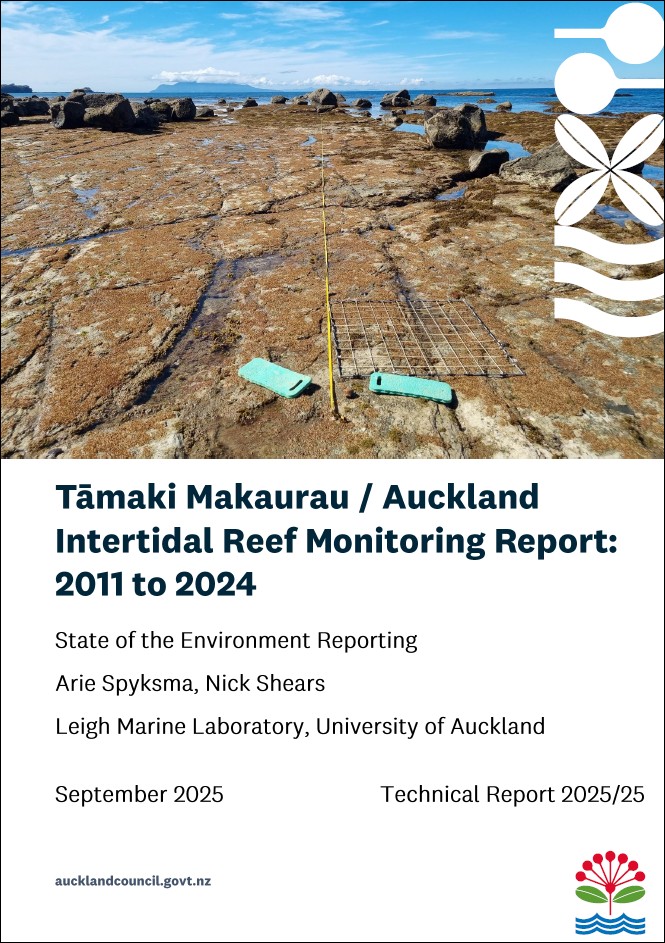Tāmaki Makaurau / Auckland intertidal reef monitoring report: 2011 to 2024. State of the environment
Author:
Arie Spyksma, Nick Shears, Leigh Marine LaboratorySource:
Auckland Council Environmental Evaluation and Monitoring Unit, EEMU | Engineering, Assets and Technical Advisory DepartmentPublication date:
2025Topics:
EnvironmentTāmaki Makaurau / Auckland intertidal reef monitoring report: 2011 to 2024. State of the environment reporting
See also
Executive summary
This report provides an assessment of rocky intertidal reef communities across the Auckland region, based on data collected from 22 long-term monitoring sites spanning Aotea / Great Barrier Island (GBI – east and west coast), the Mainland East Coast (MEC – outer to inner Hauraki Gulf), and the Mainland West Coast (MWC – open coast and Manukau Harbour) from 2011 to 2024. The monitoring programme captures regional and temporal variations in intertidal biodiversity and community structure and provides an evaluation of key environmental variables that may be driving change.
Overall, community structure and macroinvertebrate assemblages on Auckland rocky shores were similar, with a number of macroalgae and invertebrate species found throughout the monitoring network. Fetch (used as a proxy for wave exposure and energy) was the strongest environmental predictor of community assemblage, with the three highly exposed MWC and GBI sites dominated by sessile invertebrate communities and contained higher abundances of mobile invertebrates adapted for coping with high energy environments (e.g. limpets), while macroalgae dominated communities were common throughout the more moderately exposed and sheltered sites.
Sediment was also an important predictor of community assemblage with high sediment cover, which was particularly prevalent on expansive, gently sloping reefs, appearing to have a negative impact on overall species richness, and in particular macroinvertebrate populations. Signs of chronic sedimentation issues were apparent across the monitoring network but were particularly pronounced among inner Hauraki Gulf sites, where a potential shift in community composition from rocky reef to soft sediment is occurring (e.g., dense cockle beds recorded at Ōmana in 2023). Extreme rainfall events within the Auckland region in early 2023 resulted in sediment inundation of intertidal reefs throughout the MEC sites, which were coincidentally surveyed immediately after these events. This was associated with marked declines in species richness and macroinvertebrate abundances, especially in the low shore zone. These extreme weather events, which are being intensified by climate change, may provide a preview of future conditions likely to be experienced by Auckland’s intertidal reefs.
The importance of other human impacts, including recreational harvesting, invasive species, and eutrophication, remain poorly understood. Harvesting was observed at many sites, but the current survey structure is not designed to detect impacts on target species. A number of invasive species have been recorded across the survey period, particularly in the inner Hauraki Gulf, though these have tended to only constitute minor components of the reef community. Toxic filamentous cyanobacteria, such as Okeania spp., have been periodically recorded at MEC and MWC sites, with blooms occurring within the inner Hauraki Gulf.
To ensure the ongoing suitability of the monitoring programme, key recommendations include reviewing the monitoring network in 2026, adopting technologies like UAVs and photogrammetry and collecting sediment for grain size analysis. Strengthening these efforts will support better understanding and management of intertidal ecosystems in the face of ongoing environmental change.
Prepared by the Leigh Marine Laboratory, University of Auckland for Auckland Council
Auckland Council technical report, TR2025/25
September 2025
See also
